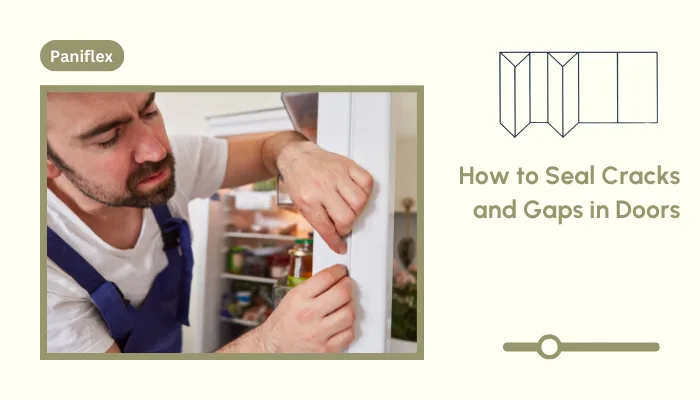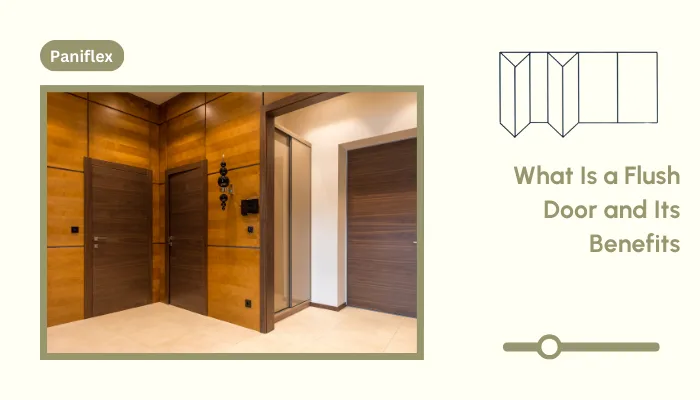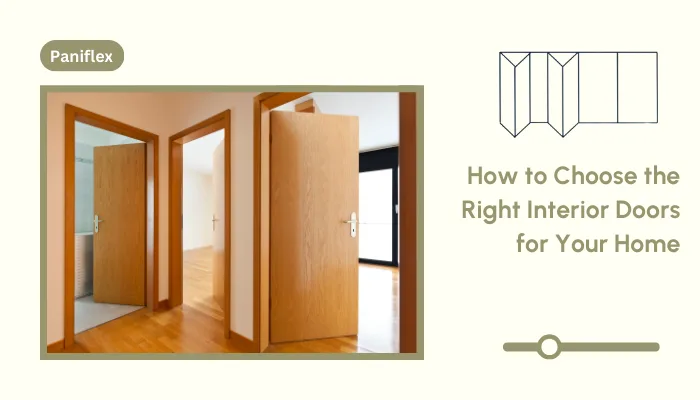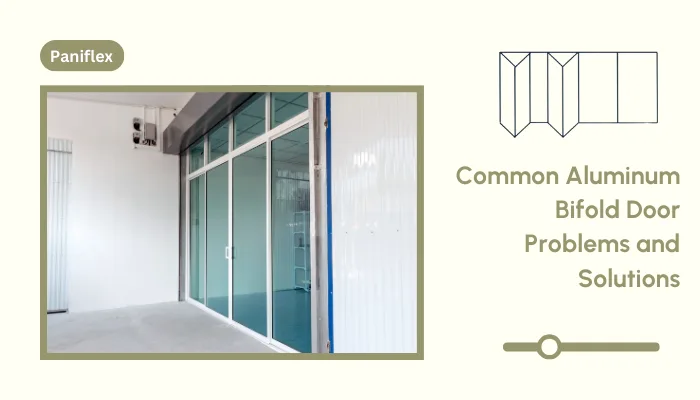Cracks and gaps around doors may seem minor, but they can significantly impact energy efficiency, comfort, and even the safety of the building. Left unaddressed, they invite drafts, pests, and moisture while increasing utility costs and reducing client satisfaction.
We understand that you are tasked with delivering beautiful, functional, and efficient spaces. Addressing these issues effectively is key to meeting client expectations. This guide outlines proven methods to seal door gaps, the tools you will need, and the considerations that ensure long-lasting results in both residential and commercial projects.
Ready to experience the benefits of custom closet doors? Explore our range of Paniflex products now.
In a nutshell:
- Sealing cracks and gaps in doors improves energy efficiency, comfort, and security while preventing drafts, pests, and moisture.
- This guide helps professionals identify when sealing is sufficient and when full replacement is the smarter solution.
- Exterior doors need stronger, weather-resistant solutions as compared to interior doors.
- Regular inspections, proper installation, and avoiding common sealing mistakes ensure long-lasting results and fewer maintenance issues.
Need for Sealing Cracks and Gaps
Sealing door cracks and gaps is more than appearances. It directly affects the functionality and performance of a space. For professionals, addressing these issues ensures that projects deliver long-term value and client satisfaction.
These are a few reasons to seal door gaps:
- Improved Energy Efficiency: Proper sealing prevents heat and cool air from escaping, helping clients reduce energy bills and maintain consistent indoor temperatures.
- Enhanced Comfort: Eliminating drafts and blocking external noise creates a more pleasant and controlled indoor environment.
- Better Security: Sealed doors minimize weak points that intruders or pests can exploit, offering clients greater peace of mind.
- Compliance with Standards: Well-sealed doors can help meet energy codes, fire safety standards, and building regulations.
To address gaps effectively, it is important to first understand why they occur. Let us explore the most common causes of cracks and gaps in doors.
Suggested Read: Choosing the Best Material for Closet Doors
Common Causes of Door Cracks and Gaps
Even well-installed doors can develop cracks and gaps over time. Understanding the root causes helps professionals select the right sealing methods and prevent recurring issues.
Typical causes are:
- Material Warping: Wood and composite doors can expand, shrink, or warp due to fluctuations in humidity and temperature, creating uneven gaps.
- Improper Installation: Doors that are not aligned correctly during installation may leave spaces around the frame or along the bottom edge.
- Worn Weatherstripping: Over time, weatherstripping can become flattened or damaged, reducing its ability to block air, light, and moisture.
- Building Settling: Structural shifts within a building can cause the frame to move slightly, resulting in noticeable cracks and gaps.
Once the cause is identified, the next step is gathering the right tools and materials to create a proper, long-lasting seal.
Tools and Materials You Will Need
Having the right tools and materials on hand ensures a smooth and efficient sealing process. The following essentials will help you effectively tackle both minor and more extensive gaps.
This table shows the tools and materials required for sealing door gaps:
| Tool / Material | Use / Purpose |
|---|---|
| Weatherstripping Tape | Creates a tight seal along door edges to block drafts and moisture. |
| Door Sweep | Closes gaps at the bottom of the door to prevent dust, pests, and air leakage. |
| Caulk and Caulking Gun | Fills small cracks around frames or trim to ensure a seamless seal. |
| Expanding Foam Sealant | Seal larger or irregular gaps where caulk may not be sufficient. |
| Screwdriver and Drill | Adjusts hinges or installs hardware like sweeps and weatherstripping. |
| Measuring Tape | Ensures precise measurements for accurate fitting of seals and sweeps. |
| Utility Knife | Used to cut weatherstripping or foam for custom sizing and clean edges. |
With the right tools ready, you can now move step by step through the sealing process to ensure lasting results.
Step-by-Step Guide to Sealing Cracks and Gaps
Sealing doors is a precise process that requires attention to detail to ensure both functionality and durability. By following these steps, contractors, architects, and designers can deliver professional results that improve comfort and efficiency for their clients.
Follow these steps for an effective resolution:
1. Identify Problem Areas
Begin by carefully examining the door from top to bottom, checking for light, drafts, or sound passing through the edges. Pay close attention to the frame, threshold, and bottom gap. Identifying every point of entry ensures you apply the correct sealing solution.
2. Install Weatherstripping
Weatherstripping is one of the most effective ways to close small gaps along the door frame. Remove any old, worn strips and measure carefully before applying new material. Choose a type suited for the door, such as foam, V-strip, or adhesive-backed, for a tight seal.
3. Install or Adjust a Door Sweep
The bottom of a door is often the most vulnerable to drafts and pests. Attaching a door sweep creates a strong barrier. Ensure it is cut to size and sits flush against the threshold without dragging, which preserves smooth operation.
4. Seal Frame Cracks
For cracks around the frame, use caulk to fill narrow spaces and expanding foam for larger, irregular gaps. Smooth the caulk line for a clean finish, and allow foam to expand and set fully before trimming excess. This step adds insulation and prevents leakage.
5. Adjust Alignment
Misaligned hinges can create uneven gaps that weatherstripping alone cannot fix. Tighten loose screws, replace worn hinges, or adjust their position to ensure the door hangs squarely within the frame. Proper alignment helps maintain an even seal around the entire door.
The approach to sealing may differ depending on whether the door is exterior or interior. Let us look at the special considerations each type requires.
Suggested Read: Guide To Sizing A Rough Opening For Bifold Doors
Special Considerations for Exterior vs. Interior Doors
Not all doors face the same demands, and the type of door directly influences the sealing approach. Exterior doors require heavy-duty solutions to withstand the elements, while interior doors focus more on comfort and privacy.
Consider the following:
1. Exterior Doors
Exterior doors are constantly exposed to outdoor conditions that can affect energy use and building comfort. Proper sealing is critical to protect interiors from drafts, water, and noise.
- Use durable, weather-resistant weatherstripping materials such as rubber or silicone.
- Install a heavy-duty door sweep to block air, moisture, and pests.
- Apply high-quality caulk or expanding foam to seal cracks around the frame.
- Choose fire-rated and code-compliant materials where required.
2. Interior Doors
Interior doors are less vulnerable to weather but play a key role in maintaining privacy and acoustic comfort. The sealing approach can be lighter but should still ensure long-term effectiveness.
- Opt for foam or felt weatherstripping for easy installation and adequate sealing.
- Consider acoustic seals in offices, bedrooms, or meeting rooms for noise reduction.
- Use low-profile door sweeps to block light or drafts without hindering movement.
- Match the finish of seals with the door’s design for a clean look.
Selecting the right sealing material is just as important as the installation itself. Let us review the main types of weatherstripping available and how they address different needs.
Types of Weatherstripping to Use
The effectiveness of sealing depends largely on choosing the right type of weatherstripping. Each option is designed for specific conditions, and selecting the right one ensures durability, efficiency, and client satisfaction.
Typical types of weatherstripping are:
- Foam Tape: Flexible and easy to install, foam tape is ideal for sealing uneven gaps along door frames. It provides good insulation and is a cost-effective solution for interior doors.
- V-Strip (Tension Seal): Made from durable plastic or metal, this option fits tightly against the door edge. It is effective for both top and side gaps, offering a discreet and long-lasting seal.
- Felt Strips: Felt is inexpensive and simple to install. Best for interior doors, it offers light sealing but wears out faster than other materials.
- Rubber or Silicone Weatherstripping: Rubber and silicone strips are excellent for exterior bifold doors. They provide superior protection against drafts, moisture, and noise, withstanding frequent use and harsh conditions.
- Door Sweeps: Attached to the bottom edge of the door, door sweeps block drafts, dust, insects, and light. Available in both brush and solid styles, they are essential for exterior and high-use interior doors.
Even the best weatherstripping requires upkeep to stay effective. Next, let us look at practical maintenance tips to ensure long-lasting seals.
Suggested Watch: Watch this video for fixing gaps under the doors.
Maintenance Tips for Long-Lasting Seals

Even high-quality weatherstripping will lose effectiveness over time without proper care. Regular maintenance ensures seals continue to deliver energy efficiency, comfort, and protection for years.
Tips for longer-lasting seals are:
- Inspect Seals Regularly: Check weatherstripping and door sweeps every six months for cracks, flattening, or gaps that may allow air or moisture through.
- Clean Contact Surfaces: Dust and dirt buildup can weaken adhesion and reduce sealing effectiveness. Wipe door edges and thresholds with a mild cleaner before reapplying or adjusting seals.
- Reapply Caulk or Foam: Caulk and foam can shrink or deteriorate. Touch up or replace sealing materials whenever you notice cracks reopening.
- Lubricate Hinges and Hardware: Properly aligned doors seal more effectively. Lubricate hinges to prevent sagging and ensure smooth, even closure.
While maintenance helps preserve seals, avoiding common mistakes during installation and repair is equally important. Let us review the errors that professionals should watch for.
Suggested Read: How to Install Bifold Door Snugger: A Basic Guide
Mistakes to Avoid When Sealing Door Gaps
Even skilled professionals can face setbacks if sealing is not approached correctly. Avoiding these common mistakes ensures the seals last longer and perform as intended.
These are a few typical mistakes made by professionals:
- Using the Wrong Material: Choosing felt for exterior doors or light foam for high-traffic entries can lead to early wear and reduced effectiveness. Always match the material to the conditions.
- Ignoring Door Alignment: Sealing a misaligned door without adjusting hinges or the frame results in uneven gaps and ineffective insulation. Alignment must be corrected first.
- Overusing Caulk or Foam: Applying too much caulk or foam can cause messy finishes and improper sealing. Controlled application provides a cleaner, more reliable result.
- Neglecting Gaps: Focusing only on the sides of the door leaves the bottom vulnerable to drafts, pests, and moisture. Always include a door sweep in the sealing plan.
Knowing what to avoid is just the first step. The next decision is whether adding new seals will solve the issue or if replacing the entire door is the better option.
Repairing a Gap vs. Replacing the Door
Not every gap requires a full replacement. Determining whether sealing is enough or a new door is necessary helps professionals make cost-effective and performance-driven choices for their projects.
Consider the following:
1. When Is Sealing Sufficient
These are situations where sealing the door can solve the problem without a costly replacement:
- The door is structurally sound and shows no signs of warping.
- Minor drafts are present around the edges or the bottom gap.
- Existing weatherstripping is worn, compressed, or missing.
- Small cracks around the frame can be filled with caulk or foam.
2. When Is Replacement the Better Choice
Some issues go beyond what sealing can fix, making replacement the smarter option:
- The door is visibly warped or misaligned despite hinge adjustments.
- Significant cracks in the material compromise security and insulation.
- Repeated sealing efforts have failed to stop drafts or noise.
- The door no longer complies with current energy efficiency or fire safety codes.
3. Balancing Client Budgets and Performance
Here are points to weigh when deciding between sealing and replacement:
- Sealing is less costly upfront and works well for minor issues.
- Replacement provides long-term durability and fewer recurring maintenance costs.
- New doors offer improved compliance with energy and safety standards.
- The right choice often depends on project goals, timelines, and client expectations.
Whether the solution is sealing or replacement, working with the right partner ensures quality results. That is where Custom Door & Mirror delivers unmatched expertise.
From the Community: Check out this Reddit thread for more innovative solutions to fill gaps in doors.
Upgrade Your Projects with Custom Door & Mirror

Choosing the right replacement door is more than a design choice. It is an investment in efficiency, durability, and safety. Custom Door & Mirror provides doors that combine modern design with long-lasting performance to meet the needs of high-traffic residential and commercial projects.
This is what sets us apart:
1. Wide Range of Designs
Our collection includes sleek contemporary options, classic finishes, and customizable designs, allowing you to align each project with client preferences and architectural styles.
2. Built for Performance
Every door is engineered for durability, security, and energy efficiency. From reinforced frames to precision hardware, our products are crafted to perform in demanding conditions.
3. Energy-Efficient and Compliant
We prioritize solutions that not only look great but also comply with energy codes and safety standards. We help interior designers, contractors, and architects deliver projects that exceed client expectations.
4. Creative Flexibility in Design
We understand that no two projects are the same. Our doors can be tailored in size, finish, and detailing, giving you the flexibility to create unique and client-specific designs without compromise.
5. High-Precision Manufacturing
Each door is crafted with advanced techniques and strict quality control. This ensures seamless finishes, accurate dimensions, and reliable performance that meet professional expectations every time.
6. Easy Installation for Professionals
Our doors are designed with contractors and architects in mind. Pre-fitted hardware and clear specifications streamline the installation process, saving valuable time on-site without sacrificing quality.
Custom Door & Mirror proudly serves Long Island (Nassau & Suffolk County), Queens, Brooklyn, Manhattan, Bronx, Staten Island, New Jersey, and Connecticut. Whether you are upgrading a single entryway or overseeing a large-scale project, our replacement solutions ensure efficiency and style.
Conclusion
Sealing cracks and gaps in doors is essential to improving comfort, efficiency, and long-term performance in any project. While minor issues can often be managed with high-quality seals and weatherstripping, many cases require a door replacement to achieve lasting results.
At Custom Door & Mirror, we provide expertly crafted replacement doors that combine durability, energy efficiency, and creative design flexibility. With high-precision manufacturing, easy installation, and support for bulk orders, we help interior designers, architects, and contractors deliver projects that exceed expectations.
Improve your next project with doors designed for performance and style. Contact Custom Door & Mirror today to discuss tailored solutions for both individual and bulk orders.
Ready to experience the benefits of custom closet doors? Explore our range of Paniflex products now.
Frequently Asked Questions
1. How do you seal a crack in a door?
Sealing a crack usually involves applying caulk or expanding foam, depending on the size of the opening. For added durability, contractors often pair these materials with weatherstripping to ensure a tight, long-lasting seal.
2. What should you fill the gaps between doors with?
For small gaps, adhesive-backed weatherstripping or foam tape works effectively. Larger gaps may require a door sweep at the bottom or expanding foam around the frame. Material choice depends on whether the door is interior or exterior.
3 . How to fix the gap between the door and the seal?
First, check if the door is properly aligned and adjust the hinges if necessary. If alignment is correct, replace the existing weatherstripping with a more durable type or add a door sweep to close the space.
4. How to seal cracks and openings?
Use caulk for narrow cracks and expanding foam for larger openings. For ongoing protection, install weatherstripping or door sweeps. Regular inspections ensure the seals remain effective against drafts, noise, and moisture.
5. When should a door be replaced instead of sealed?
Replacement is recommended if the door is warped, damaged, or misaligned to the point of being beyond repair. In such cases, sealing alone cannot restore optimal performance, and a new door ensures improved security, enhanced energy efficiency, and compliance with building codes.
6. What types of weatherstripping last the longest?
Rubber and silicone weatherstripping typically lasts the longest, especially on exterior doors. They withstand frequent use and harsh weather conditions, providing superior insulation compared to felt or foam options, which are best suited for lighter, interior use.
7. How often should door seals be checked or replaced?
Inspect seals every six months for wear, cracks, or flattening. Weatherstripping may need replacement every one to three years, depending on traffic and conditions, while high-quality silicone or rubber options can last significantly longer.






